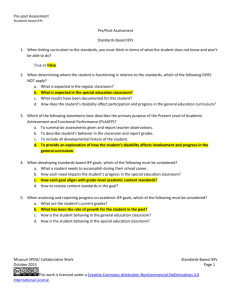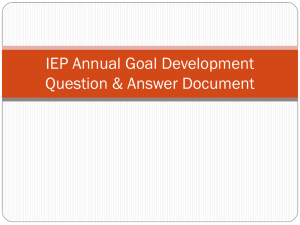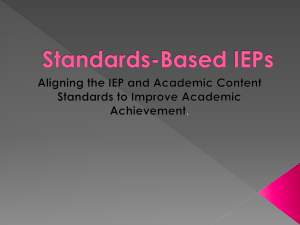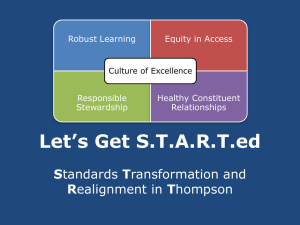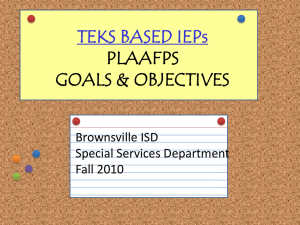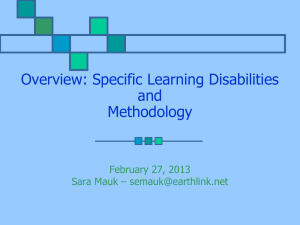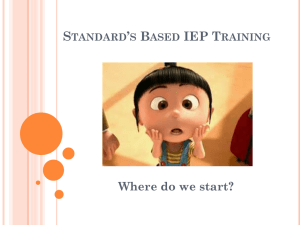Standard Based IEP
advertisement
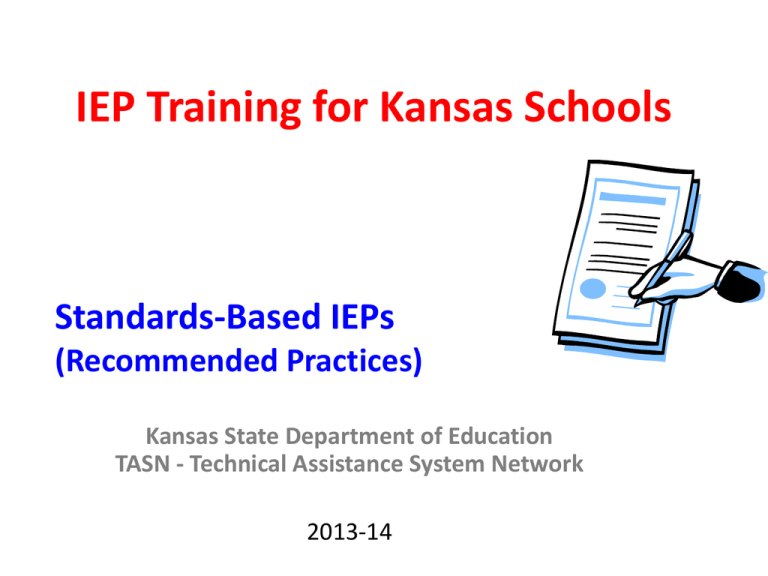
IEP Training for Kansas Schools Standards-Based IEPs (Recommended Practices) Kansas State Department of Education TASN - Technical Assistance System Network 2013-14 Agenda www.ksdetasn.org • What is a Standards-based IEP? • Steps to develop a standards-based IEP: 1. Use PLAAFPs to link to the Standards 2. Choose a standard related to a prioritized need and analyze skill components 3. Select a skill component and develop a goal 4. If needed, write Short-term Objectives or Benchmarks 5. Collect progress monitoring data 2 What is a Standards-based IEP? • A process and a document that is framed by the Kansas College and Career Ready (KCCR) Standards to ensure instructional accountability for each student with a disability. • A plan that contains goals individually designed to facilitate the student’s achievement of grade-level state content standards. • The cornerstone of access to the general education curriculum for students with disabilities. 3 How Do IEP Teams Align IEPs to Standards? • Refer to the KCCR standards to determine expectations at the student’s enrolled grade level • Use the standards as a guide to determine what is important for the student to learn or be able to do • Conduct an analysis to determine the gap between grade level standards and the student’s current skills and knowledge 4 Benefits of a Standards-Based IEP • Provides all students with the opportunity to learn and make progress in grade-level academic standards. • Provides students taking alternate assessments with the opportunity to learn and make progress on grade-level standards in a manner that is appropriate to their individual needs. • Ensures compliance with federal and state requirements related to access to the general education curriculum grade level standards. • Ensures every member of the IEP Team, including parents and guardians, have knowledge of state content standards. • Ensures that parents have a better understanding of expectations for students in their child’s grade level. • Supports a collaborative working relationship between general and special education teachers. • Prepares students for success in post secondary environments. 5 School Curriculum Must Align with State Standards KCCR Standards: • Provide instructional accountability • Drive general education content instruction • Define the expectations of all students, with or without disabilities • Can provide a structure for linking the IEP to the general curriculum 6 Why Connect IEPs to Standards? • Helps support accountability for the student and the system • Supports each student’s access to and progress in the general curriculum • Essential for closing the achievement gap • Supports achievement of performance goals for all students • Promotes a single system of education—a common language and support for LRE • Encourages greater consistency across schools and districts • Helps create high expectations for all students 7 Connecting IEPs to Standards… Does NOT mean – • Writing goals that restate the standards • Using the academic standards alone to determine goals • Assuming that every student will work only on grade level content 8 Connecting IEPs to Standards… Does mean – Referring to standards to determine expectations at grade level Using the standards as a guide to determine what is important for the student to learn or be able to do Conducting an analysis to determine the gap between grade expectations and current skills and knowledge 9 Sequence for Building a Standards-Based IEP 1. Consider the grade-level content standards Examine standards. Discuss expected knowledge and skills Consider prerequisite knowledge and skills 2. Examine student data to determine where student is in relation to grade-level standards Compare standards with student’s current instructional level Gap Analysis 10 Getting Ready for Developing a Standards-Based IEP Develop knowledge of the standards – Curriculum guides – Extended standards or links to standards Make sure student data is current – Evaluation/reevaluation data, if current – Progress monitoring data – Current state assessment results – Classroom assessment data 11 General Educators can provide information about: • Classroom expectations (related to the standards) for grade-level peers • How the student with a disability is currently performing in the classroom • How the student’s disability impacts his/her performance in the general curriculum, across achievement domains • Impact of accommodations being used 12 Think and Discuss How have the KCCR Standards shaped instruction in your school for students in general education? For students in special education? 13 1) Use PLAAFPs to link to Standard • PLAAFPs must include information about: – Current performance – Impact of exceptionality – Baseline data for identified need 14 PLAAFPs Must Include CURRENT PERFORMANCE IMPACT OF EXCEPTIONALITY BASELINE DATA FOR IDENTIFIED NEED 15 The Impact Statement Describes the Student’s Involvement in the General Curriculum Think about the following questions: 1. How does the student’s disability impact the student’s involvement in the general education curriculum? 2. What academic areas are impacted due to the disability? Example: • Ann’s disability in the area of auditory processing and auditory memory causes her to have difficulty processing problems and remembering information presented orally. This impacts her comprehension and her ability to follow multi-step directions and recall complex concepts. This also impacts her academic success in all instructional settings with oral presentations, including reading, written language, and math, and to a lesser degree, science and social studies. 16 Possible Data Sources for Linking PLAAFPs to Standards • Progress monitoring results (review of achievement of previous IEP) • Classroom tests • Student work samples • Curriculum-based assessment • Formative, benchmark and summative assessments • Results of most recent state assessment 17 Questions to ask about PLAAFPs and Standards • • • • • • What has been the student’s response to learning strategies? How do learner characteristics affect student learning? What have been successful interventions or accommodations? Which need presents the biggest obstacle to the student’s progress toward grade-level standards? How does the child’s disability impact his/her involvement and progress in the general curriculum? What are the skill sets the student requires to access and make progress in general education curriculum? 18 Questions to ask about PLAAFPs and Standards • What is the student’s current performance in relation to the grade-level content standards? • What state standards has the student achieved? • What skills does the student already have that will enable him/her to work toward standards for the student’s current grade level? • What skills are missing in order for the student to be able to achieve the grade level standard? • What are this student’s high priority needs that you might want to develop goals to address? 19 Consider Gap Analysis A gap analysis is used to measure and analyze the difference between the student's current levels of performance and grade-level content standard expectations. What prerequisite skills or knowledge does the student need to close the gap between his/her Present Level of Academic Achievement and the grade-level content standards? 20 Activity: Conducting a Gap Analysis 1) Compare the student’s present level of performance to the expectations of the grade-level content standard. 2) Where are there gaps between the present level and the standard? 3) What skills does the student need to move from current level to the level of the standard? 4) At what grade level are the pre-requisite skills needed by the student taught? 21 Activity: Gap Analysis • PLAAFP: Richie can add and subtract single digit numbers with 90% accuracy. He can add double digit numbers with 50% accuracy but he is unable to subtract double digit numbers that require regrouping. He can identify coins and small bills (penny, nickel, dime, quarter, one, and five dollar bills) but he cannot make change. Richie can estimate two-digit numbers but not more than that. • Standard: The fourth grade standard for math requires the following computation: Add, subtract, multiply (three-digit by two-digit factors), and divide (two-digit dividends by one-digit divisors) to solve problems. 22 Questions for IEP Teams to Consider when Conducting a Gap Analysis • What is the intent of the content standard? • What is the content standard saying that the student must know and be able to do? • What are the essential skills associated with the content standard? 23 Gap Analysis: Other Questions to Consider • Has the student been taught content aligned with the grade-level standards? • Has the student been provided appropriate instructional scaffolding to attain grade-level expectations? • Does the student have an appropriate means to express what he or she knows relative to the content standard? • Was the student provided core and supplemental materials in an accessible format? • Is assistive technology needed to access instruction in the general curriculum? 24 2) Choose a standard related to a prioritized need and analyze the skill components • Selection of a standard should be related to a highpriority need for which you want to write a goal (remember not all needs will be addressed through goals) • Not all standards are equally important for a student • Consider – Vision for the student – Impact of the standard on skills needed for success in subsequent grade levels – Impact of the standard on skills needed across achievement domains 25 Choosing and Analyzing a Standard Choose the standard(s) most essential to • Accelerating the student’s ability to progress in the general education curriculum • Result in educational benefit • Reduce the difference between student’s performance and grade level standards (Gap Analysis) Unpack the standard—Break it into sub-skills Identify the critical skill(s) needed to demonstrate proficiency of general education curriculum expectations at the student’s enrolled grade level 26 Prioritizing the Standards Which standards: • Will most influence the student’s ability to progress in the general education curriculum? • Will most likely result in educational benefit for the student? • Can be met with accommodations in the general classroom? • Require specialized instruction? 27 Selecting the Standard Determine which standards are most important for each student (based on progress in the general education curriculum) Compare standard(s) with student’s areas of need and the impact of the disability Use data to determine the areas the student will find difficult without additional supports 28 Analyze skill components within the standard • What is the standard saying the student must know and be able to do? • What are key vocabulary? • Look at degree of difficulty and complexity of the skills within the standard. • What are the pre-requisite skills? • Identify where the student is performing within the skill hierarchy related to the standard. • How does the student’s disability and learning characteristics affect progress in this standard? (adapted from Carol Kosnitsky, 2012) 29 Drill Down Teach Up • It is important “to drill down into a set of standards and determine which are the critical elements, and then figure out how to get a child to a point where he or she can understand those elements.” (Margaret McLaughlin, University of Maryland at College Park) • Higher expectations create the need to teach with higher intensity 30 Activity: Link PLAAFP Need to KCCR Standard Directions: 1. Select either the PLAAFP Example for Grade 4 (Sally) or for Grade 8 (Kimi). 2. Link a need from this PLAAFP statement to a KCCR standard for the student’s grade level. 3. Analyze the skill components of that standard. 4. Which skill components are related to this student’s current levels? 31 3) Select a skill component and develop a goal • Remember that a goal has 4 Components: a. Behavior b. Conditions c. Criteria d. Timeframe 32 Develop a goal • The goal may relate to a missing pre-requisite skill for a standard. • The goal should describe what the student will accomplish in one school year. • Remember the required components of a goal: – – – – Behavior/skill Conditions Criteria Timeframe 33 Issues to consider when setting goals • If you want the student to move closer to grade-level standards, the student may need to achieve more than a year’s progress in a year’s time. • Only very intense instruction can achieve this level of progress for students who have chronically made less than a year’s progress year after year. 34 When Developing Measurable Goals Aligned with Grade-Level Standards • Goals should build on current strengths or address specified needs of the student • Goals are targeted WITHIN the general education curriculum o Not a restatement of the standard o Do not take the place of the curriculum o Goals for behavior, life skills, and other areas may also be targeted 35 Consideration of the Standards • Intent of the standard • Skills needed to meet standard Includes depth of knowledge New skills and extensions • Knowledge and skills that should be in place in order for student to meet standards Prerequisites Connections to previous learning • Methods for showing what the student knows and can do within the standard 36 Example: Measurable Annual Goals Standard: ELA Gr. 4 RF Standard 3 Skill component: Applying phonics and word analysis to decode words Measurable Annual Goal: In one semester, Larry will correctly decode words in isolation with an average of 90% accuracy when given a list of 25 unfamiliar multi-syllable words out of context. 37 Activity: Measurable Annual Goal for Sean Goal: In 36 instructional weeks, when given 10 questions per passage, Sean will answer with 90 % accuracy comprehension about fourth grade level literary and informational text. Sean is a 4th grader. • What KCCR ELA 4th grade standard is aligned to this goal? • To what specific skill component of that standard is the goal linked? 38 Think and Discuss • Sean’s PLAAFPs indicate that he is able to accurately decode literary and informational text at a first semester, third grade level. Do you think this goal is appropriate for Sean? • Sean’s baseline data indicates that his comprehension with beginning third grade text is 80% on a maze test. Do you think the goal is written appropriately? How will you measure progress? 39 Activity: Measurable Annual Goals Directions: • Chose the activity for Sally or Kimi, depending on which student PLAAFPs you used in a previous activity. • Develop a measurable goal for Sally or Kimi, based on the analysis of the standard from the earlier activity. Use the 2 X 2 table found on the next slide and in the Activities handout. 40 Measurable Annual Goal: _______________________________________________ _______________________________________________ _______________________________________________ Behavior Condition Criteria Timeframe 41 4) If needed, write Objectives or Benchmarks • Short-term objectives and benchmarks are steps that measure the student’s progress toward the annual goal. • These should provide a clear mechanism to evaluate the child’s progress. • They are a logical breakdown of the major components of the annual goal. 42 Short-Term Objectives and Benchmarks • Are required only for those students taking the Kansas Alternate Assessment and DLM • ALL goals on an IEP for a student taking the Kansas Alternate Assessment must include benchmarks or short term objectives 43 Short-Term Objectives • Are sequential, progressive, intermediate measures of progress toward the annual goal • Are restatements of the goal with a different criterion 44 Benchmarks • Are milestones that describe content to be learned or skills to be performed • Are used when progress is not easily quantified and is based on task analysis • Are distinct skills that are often independent of each other but must be combined to meet the measurable annual goal 45 Activity: Complete the steps for Marco 1) Identify a 7th grade math standard that is related to Marco’s PLAAFP. 2) Identify the component skills of the standard. 3) Develop a measurable annual goal that is related to the component skills of the standard. 46 Activity: Complete the Steps for Marco Directions: Identify a math standard for seventh grade that is related to the following PLAAFP. Develop a measurable annual goal for Marco that is related to the component skills of that standard. PLAAFP: • Marco knows all the addition and subtraction facts, but he has memorized the multiplication and division facts only through fives. However, he has good calculator skills and is able to correctly solve two-step word problems using a calculator. He is currently working on addition and subtraction of fractions. He does not yet understand the relationship between fractions and decimals. He has begun to compute addition and subtraction of negative and positive whole numbers, using a number line that extends both above and below zero. 47 5) Collect progress monitoring data to measure progress toward the goal Progress monitoring data answers the following questions: • Is the student making progress toward his/her goal? • Are instructional adjustments are needed? • Are the special education services and supports being provided effective in helping the student to reach his/her goal? 48 Collect Progress Monitoring Data • Identify the skill in the goal that will be monitored and the measurement to be used • Develop a chart to track the data • Develop an aimline (a line from the baseline score to the criteria in the goal) • Determine how often to collect data • Make instructional adjustments based on the data • Make progress reports to parents consistent with the schedule in the IEP 49 The Trendline Won’t Meet the Aimline— Intensify Instruction 50 Intensifying Instruction • Some options for intensifying instruction are: – Increase the number of practice opportunities or provide practice opportunities with adult support present – Reduce the size of the group or move to one-on-one – Spend more time modeling the “I do” and “We do” guided practice before the student practices independently – Increase the length or frequency of the instructional intervention – Use a more systematic program/curriculum so that skills are taught in a more prescribed manner – Provide better access to instruction through assistive technology – Provide additional special education services and supports 51 Review • Standards-based IEPs are a recommended but not required practice. • The IEP should not merely restate the content standard, but should specify the skills the student needs to acquire in order to make progress in achieving the standard, thereby accessing the general education curriculum. • Annual goals in a standards-based IEP are related to needs resulting from the student’s disability that directly affect access to and progress in the general education curriculum. 52 Standards-Based IEPs are about Access to the General Curriculum • How do we make sure that students with disabilities have access to the higher-level skills that are embedded in the KCCR Standards? • The focus has shifted from physical access (mainstreaming) to access to the general curriculum, and making schools accountable for the progress of all students within the state’s standards. 53 Access to the General Education Curriculum for Students with Disabilities ACCESS is: • Students with disabilities actively engaged in learning the content and skills of the general education curriculum. 54 Access to the General Education Curriculum for Students with Disabilities ACCESS is not: • A student with a disability sitting in a general education classroom doing work that is unrelated to the gradelevel content standards • A student with a disability sitting in a general education classroom listening to content that is meaningless to the student because it is too difficult and has not been adapted for the student’s needs. 55 Access to the General Education Curriculum for Students with Disabilities • It is essential to determine how a student with a disability will participate in the content of the general education curriculum. – Differentiated instruction and assessment – Adapted accessible materials • The student’s strengths provide the best information to determine how the student can access the knowledge and skills of the general education curriculum. Principles of Universal Design 56 Standards-based Instruction • Standards-based instruction is a process for teaching all students using a curriculum that is clearly defined by academic content standards for the purpose of improving academic performance. • A fundamental principle of standards-based instruction is to have consistent expectations for all students. This may be facilitated through use of different materials or strategies to master a content standard. 57 Collaborate to build implementation of effective instructional practices • Universal design for learning (multiple ways of presenting information, multiple avenues of student response) • Explicit instruction • Scaffolded instruction • Systematic instruction • Differentiated instruction • Sufficient opportunities for practice (with corrective feedback) 58 Reminders • The IEP goal should NOT be a restatement of a state standard • Don’t forget that some goals may need to address skills other than academics. • Remember to consider how the use of accommodations and/or assistive technology might enable the student to access the general curriculum more effectively. 59 60 61 References • Assessing Special Education Students SCASS (2012). Module 1: Introduction to Standards-based IEPs [Power Point slides]. Washington, DC: Council of Chief State School Officers. • Assessing Special Education Students SCASS (2012). Module 2: Standards-based IEPs: Developing Present Levels of Academic Achievement and Functional Performance. [Power Point slides]. Washington, DC: Council of Chief State School Officers. • Assessing Special Education Students SCASS (2012). Module 3: Standards-based IEPs: Writing Measurable Annual IEP Goals. [Power Point slides]. Washington, DC: Council of Chief State School Officers. • Kosnitsky, Carol (March, 2012), Writing IEPs that Align to Common Core Standards, presentation for Alabama CASE Spring Conference, Birmingham, AL. 62
